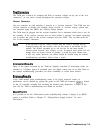
Automatic
Fault
Isolation
Automatic fault isolation (AFI) is designed to isolate most faults to one or two assemblies.
AFI can be run with the spectrum analyzer cover in place and requires only the CAL
OUTPUT signal as a stimulus. The entire procedure takes less than 2 minutes to complete if
no failures are found.
AFI performs checks of five functional areas in a pre-defined sequence. The sequence
minimizes the chance of making false assumptions. The TAM checks the spectrum analyzer
“from the inside out.” For example, the ADC is checked before the IF is checked. This
ensures that if no signal is detected through the IF, the fault is in the IF section and not a
faulty ADC. The ADC measures the video signal from the IF section.
The sequence of checks is as follows:
1. Controller check
2. ADC/interface check
3. IF/log check
4. LO control check
5. RF low band check
Note
Only the low band of the spectrum analyzer is checked by AFI. This is
because the only stimulus to the RF section is from the 300 MHz CAL
OUTPUT signal. A signal greater than 2.9 GHz would be required to check
the high band path.
Display/Power Supply
AFI cannot check the display/power-supply section because this section powers the TAM and
provides the display of AFI results.
Controller Check
The TAM performs a check-sum of all ROMs,
RAMS,
and the EEROM. The CPU is also
checked, since parts of the CPU could be nonfunctional while the TAM still operates. These
checks are very similar to those done by the spectrum analyzer at power-on.
ADC/lnterface
Check
The keyboard interface and strobe-select circuitry must be functioning correctly, since these
are required to operate the TAM. The TAM checks the ADC by attempting to measure three
signals from three different locations. This ensures that an open or short in one cable will
not hide the fact that the ADC is operating satisfactorily. The analog bus (W2 control cable)
is checked by sending data out on the data lines and reading the data back. If this check
fails, disconnect one board at a time and rerun AFI to determine if an assembly causes the
problem. If the fault remains with all assemblies disconnected from W2, troubleshoot W2 or
the A3 interface assembly.
IF/LOG Check
The TAM uses the cal oscillator on the A4 assembly as the stimulus for checking the IF
section. If the signal is undetected, the TAM repeats the test with a signal originating from
the RF section. Presence of this signal through the IF indicates a faulty cal oscillator.
7-14 General Troubleshooting


















